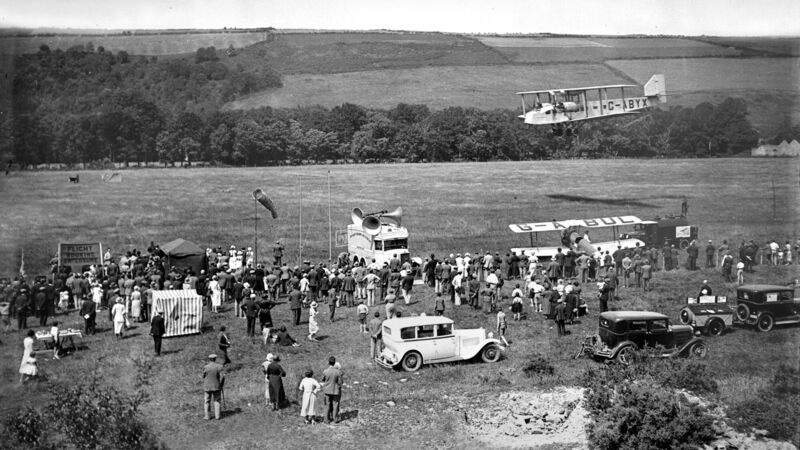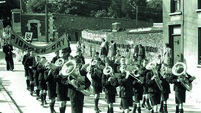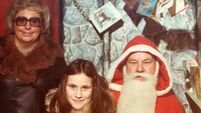Ticket to ride: Mum’s 1933 raffle prize was a spin in a plane

Crowds at the Cobham's flying circus event at Ballincollig in 1933
Farmer John O’Connell faced a dilemma that summer’s day in 1933.
His 21-year-old daughter, Mary, had won a raffle to fly in one of those new-fangled aeroplanes when the famous Alan Cobham’s Flying Circus attraction came to Cork in July.
John, 63, wondered should he allow it. His wife, Catherine, had died just six months earlier and it is little wonder he felt protective to their two daughters.
In an era when travel was predominantly horse and trap and bicycles, going up in a plane was risky. John had often read in the Examiner of fatal air accidents. Should he give his blessing to his youngest daughter? It would involve her travelling 30 miles from their home at Coolbay Cross in Cloyne parish to Ballincollig, on the other side of Cork city.
John teased it out. Mary had attended the Eucharistic Congress in Dublin a year earlier, it was true, but then she was travelling with a group of pilgrims, and accompanied by a curate from their parish.
This popular air show was different, and was bound to attract young men in search of adventure. And Ballincollig still had a reputation as a garrison town populated by soldiers.
John sought advice from relatives, neighbours and farm hands before reaching a decision: he agreed to Mary’s excursion, on condition there would be no overnight stay, and that Mary’s elder sister Kathy would act as chaperone. It was decided: Mary would get to fly after all!
******
With the sun inching over the horizon on Thursday, July 6, 1933, the alarm clock went off in the Cloyne farmstead. Half asleep, Mary turned it off.
She and Kathy had decided on an early start, to make the most of the exciting day ahead. She got out of the bed she shared with Kathy and lit the globe oil lamp on the dressing table. Kathy got out too and, with the aid of a hand-held bicycle lamp, went downstairs to the kitchen to light the prepared range, to make porridge and boil the kettle for tea.
Having washed, Mary got into her flying attire — a calf-length flared floral summer dress. She needed to be agile to climb into an aeroplane, so had decided not to wear her bone-ribbed, tight-fitting laced corset. She put on the low-heeled walking shoes she normally reserved for Mass.
Mary then put on her lipstick and Ponds face powder, unhooked her overcoat from behind the door, and went downstairs.
After breakfast, and with the preparations for the farming day ahead complete, the sisters went outside and collected Dobbin from the adjacent paddock, put on the gelding’s tackle and hitched him to the horse trap.
Their father had, the evening before, checked there was oil in the carriage lamps, and had a large bag of hay and a bucket ready for the two and a half hour trek to Midleton train station nine miles away.
On arrival at the station, the sisters opened the door to the yard of a public house next door, unhitched the trap from Dobbin, took off his tackle, and led him by the mane to a gated, covered enclosure where he would rest until their return, alongside his hay and water.
The girls boarded the train to Cork city, then took a special excursion bus for the makeshift airfield in Ballincollig.
On arrival, Mary was told it would be two hours before she would climb into one of Alan Cobham’s windowless planes.
The sisters spread out the travel rug on a bank of rough grass and watched the acrobatic spectacles, whilst enjoying some of the picnic they had brought.
Along with the rest of the large crowd, they gasped in amazement at the stunts by the pilots and aviators, who at the time were known as ‘barnstormers’. These included standing on the wings of planes in full flight, planes flying in military formation and upside down, and men jumping from the wings of planes and parachuting to the ground.
Eventually, Mary was called to board a plane and was airborne, the slipstream blowing her hair horizontally behind her. She took in the views as she flew over the River Lee to Cork city and back, and felt airsick when the pilot did some minor stunts.
After 20 minutes, the plane raced back to the makeshift grass runway and came to a halt.
After all that excitement, the sisters took the excursion bus back to Cork city to do some shopping in Cash & Co in Patrick Street. But there was more drama to come that day. As they strolled through the city, Mary’s handbag was snatched from her hand and the thief vanished into the crowds.
From that day on, Mary never visited Cork city without a large pocket sewn inside her overcoat where she kept her purse.
The sisters headed home, and met their father standing in the middle of the road at Coolbay Cross, who guided Dobbin by the bridle back to the farm.
Not long after, John O’Connell got into bed in his Long Johns. In the dark, he reached under the bolster pillow for his rosary beads, and thanked God for the safe return of Mary and Kathy. He did not pray for the soul of, or curse, the thief who stole Mary’s handbag. The sisters had decided not to tell their father about that.
******
John O’Connell was right to be apprehensive about flying.
Cobham’s Flying Circus left Cork after its two-day stay and set up in Ballycummin, Limerick, the next day, July 7, 1933.
During that show there was a mid-air crash between two planes, and two people in a Gipsy Moth were killed — the English pilot, and William Ower, 28, a motor mechanic from Newcastle West, who, like Mary, had won his flight in a raffle.
That could have been my mother. Such is the lottery of life.
Joe Terry is the author of two novels, The Curse Of The USS Annie Oakley and The Undoing Of Luke O’Reilly, available in public libraries and online.







